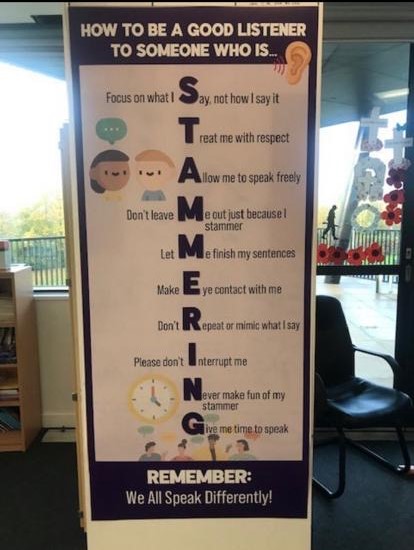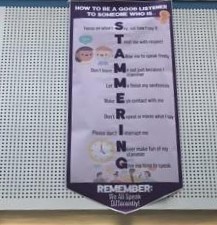As a speech therapist working with children and young people who stammer, and as I don’t stammer myself, nothing gives me greater joy than working collaboratively and listening to the children’s voices to shape and influence my work. But more, I love to include them in the things I do and the messages that we then share about stammering in our local community. I run stammering training for school staff and am always accompanied by a client (now an ex-client who is only 17), and she co-presents a section of the training. She is committed to making a difference to the lives of children who stammer at school because she doesn’t want anyone to experience what she did. It is this that has motivated her, been her drive to better educate others about stammering, to raise awareness, and to share the idea that it is okay to stammer. She is a passionate advocate for stammering acceptance and strives to create an environment that is accepting of communicative diversity. I truly believe that her voice is powerful, beautiful and incredibly important, and by speaking up, she is challenging the stigma and stereotypes and showing our schools that you don’t need to speak a certain way to be effective as a communicator and is paving the way for others to stammer freely. I’m also grateful that she inspired the work in the picture.
During one of the training sessions, she was asked what staff could do to make a difference. She talked about the fact that she had never seen a poster in her school about stammering as she had for other differences. She felt that schools needed to speak about stammering more and make it more visible and this she hoped would reduce teasing and bullying. (She was shortlisted to the finalists for the National NHS Unsung Hero Awards, in the category of Volunteer of the Year for her work.)
I shared this information with a group of children who stammer who all attend a local high school. They decided that they would like to make some posters about stammering for their school. Their school offered amazing support and had their work made into banners, displayed in their entrance hall, and hung from a mezzanine floor, for all to see! We also collaborated with the charity, Action for Stammering Children (ASC) and so the posters have now been launched nationwide in the UK. You can find their posters here: https://actionforstammeringchildren.org/resource/about-my-stammer-school-posters/
Sadly, the poster, made by my 13 year old, never made it onto the ASC website, yet it is one of my favourites and one that I think needs to be seen. I love the message it conveys to others about how to be a good listener to someone who is stammering!! I’m delighted that it has such a prominent position in the school and hope that other children in the school reading it, learn some important messages about the power of listening.


![]()


Nic, what a great way to teach self-advocacy and to take action in such a tangible way. Bravo to the children who contributed!
Ana Paula
Thank you so much Ana Paula – I will let the young people know what you’ve said. I think they will be thrilled. I’m really proud of the fact that their great work was self initiated. Their work will not only benefit themselves, but also others who stammer within the school, and of course all their listeners (including the teachers)!
I love that the posters came to fruition after a simple question asked at one of your events. And even better that the posters were designed by the kids 🙂 I like the design of the one in the photo. Very effective and eye-catching!
Thanks Daniele. It’s so great that the kids wanted to create something for their school – I had suggested a social media design/post, but they were sure they wanted posters! Thanks for your kind words too about the design!
This is such a wonderful idea! Have you received any feedback on what has happened since the posters went up? I would wonder if and how this might have contributed to young stammerers’ experience and general attitudes of children in the schools. Great work!
Thank you Daniel! I haven’t received any feedback yet…..however I would love to know. The school not only shared this poem, but put up a huge display with information about stammering, along with a stammering pride flag. I will definitely endeavour to find out this information and I think it would encourage other schools in our area to take a similar approach
I really appreciate the way this project empowers children to be active subjects rather than mere objects of study. Involving them in creating awareness and messages about stuttering nt only gives them a voice, but also fosters a sense of autonomy and ownership of their experiences.
Bravo Nic!
Thank you Andrea. I absolutely agree with you! It’s so much more meaningful and powerful when the words come from within.
I loved this Nic, thank you so much.
Thank you Fernanda for your lovely comment! I will be sharing the comments with the young people, so I know they will mean a lot.
I loved this, Nic! I think it’s awesome that you’re giving these kids a platform to make a real difference – including here on the ISAD, too. They should be proud, and so should you. Thank you for sharing!
Thank you so much for your kind words, Gina! You can probably tell how proud I am of them. I love to celebrate their successes and achievements
Nic,
This is SO cool and awesome. I love that you were able to collaborate and give your client the spotlight this poster and story deserves! I have a question: With future clients, would you consider creating more graphics (but personal to the client) during a session to? And have them answer the question “what stammering mean to them” while using this word Stammer as an acronym. This would be a great activity to do during a closing meeting!
Thank you so much!!! And absolutely yes. That is a great idea! It would be really interesting to do this at a closing meeting. I think it would be interesting to do at the start too and find out if their perspective changes! In therapy, I think it’s important and helpful for some to explore stammering in different ways, to enable people to express their thoughts, feelings, experiences in a variety of creative forms.
I truly enjoyed reading about your collaborative approach with children who stammer. It was inspiring to hear how you include your clients in training sessions, empowering them to share their experiences and advocate for stammering acceptance. This approach not only challenges stigma but also fosters a sense of community and support. The story of your client’s advocacy work, including the posters initiative, illustrates the impact of making stammering visible in schools. How do you see this approach shaping future efforts to promote stammering awareness in educational settings? Do you think it might be normalized and decrease bullying?
Thanks so much Annet. One of my biggest hopes from the work I do is to increase the visibility (and sound) of stammering in schools. I think training staff is important, and it is important to me that a person who stammers collaborates in delivering this training. I think that personal contact can help to reduce stigma and discrimination and decrease negative stereotypes. Another aspect is educating peers – I really hope the posters do a little bit of that. A few years a go I obtained charitable funding to purchase a book, (The Boy who Made Everyone Laugh, by Helen Rutter which is about a boy who stutters), for all the schools in the area I work. With that, I worked collaboratively with the young people who stutter to produce a short video for class and year group assemblies – the kids said what they wanted their peers to know about stuttering. We have a web page with a lesson plan for teachers to use and different resources. The thing I love most about this is that stuttering is heard in our schools – and I do believe that this will help in reducing teasing and bullying and will help in normalising stuttering. Children can then grow up with a peer group who know more about and are embracing of stammering. The video we produced was for older children. I really believe that our education needs to start young. Little children need to grow up knowing more about and hearing stammering, so I have a little video that can be shown to kids as young as 4 years old in their class in something called ‘circle time’. Again, this has been made by my kids who stammer. Thanks for your questions, I hope I have touched upon some of the things you’d hoped for.
I love this idea for teaching self-advocacy and for helping students gain more insight into how their differences make them who they are! How much guidance/help did you provide the students who created the posters? I think this would be a great task/activity to include in sessions!
Thank you so much. I had been working with the students for differing amounts of time each before they came together as a group. We probably had around 6-8 group sessions from recollection. The posters were created completely individually, my specification was simply to create something to raise awareness, something that they’d like others to know about stuttering. (I’d originally suggested a design for a social media post, but based on the info I had given them about what my ex-client said during our training, they were adamant that they wanted to create posters for their school). Of course, the therapy I offer aims to empower people to use their beautiful voices, to feel accepting, embracing and even proud of their stuttering identity, to be able to self advocate and say what they want to say, when they want and that their voices matter.
Nic,
I genuinely enjoyed reading about you and your client’s dedication to educating others and raising awareness for stammering acceptance. Increasing a client’s ability to self advocate is so important! These community efforts truly have a lasting impact on individuals who stammer as it plays a vital role in reducing stigma.
Andrea,
Thank you for you kind comment. I really appreciate you taking the time to respond. The power of the community! I am so enthused seeing the changes happening within society before my very eyes (although, I know we still have a long way to go).
Hi Nic!
I really enjoyed reading your paper! It is so inspiring to hear how you are empowering children and young people who stammer by giving them a platform to share their experiences and make a real impact in their communities. Including your former client in the school training presentations is such a powerful way to advocate for stammering acceptance, and it is clear how much she has influenced others through her dedication and passion. It is awesome to see how these efforts are not only raising awareness but also creating spaces where stammering is better understood and accepted.
Thank you for sharing!
Elisa
Oh Elisa, thank you for getting in touch to say that. I can honestly say that it is a real privilege to watch the young people have agency and feel empowered to let others know what they want them to know, and all the while blossom into advocating for themselves….and others.
Hello Nic, How wonderful that as a part of your work for the NHS you present workshops to educate school staffs about stammering, and even better that your former client accompanies you, to share her personal experiences with stammering.
I am glad that these posters also came from your work, to give young people an artistic platform to express their thoughts about stammering. Thank you.
Thank you Jeff! I’m always delighted to see the creativity and dedication to making a difference the young people I work with have.
What a great idea, Nic! I’ve been speaking in many classes and every time I find that many schools have too little knowledge, that stuttering is not “interesting” and pushed into the corner, kids who stutter afraid to talk about it, teachers afraid to ask, students not knowing how to react. This project opens every door, every conversation! I wish every school would not only learn more about stuttering, and not only notice stuttering and the ISAD, but also use Dec 3, the international day of people with disabilities, to have activities, where stuttering is one of them. When talking in schools I bring my DAF, as this gives a feeling of how it may feel to not being able to speak the way you want to. They can practice talking, while the other is continously interrupting. Older kids can try to speak with pebbles in their mouths. Any way to normalize stuttering and make it discussable. And also to simply use the word: stuttering. There are words that are not OK to use, so we hide them or cover them under “nicer” words. When we use the word stuttering in the right way, we help normalizing it, just as we’ve normalized many other words and varieties that were “wrong” before. I so love this and wish this would find a place in every school, every children’s health care, and every SLP room. Give that girl a huge hug from me. <3
Keep them talking
Anita
Oh Anita! Thank you so much! And absolutely! Here here! I’ve mentioned this is another reply somewhere, but I absolutely believe that we need to be talking about stuttering in all our educational settings and even with really little ones. With my kids, I’ve developed a ‘circle time’ video to be shown in schools with children as young as 4 and 5 – so they hear stuttering, know what it is and know how to respond with kindness. Our kids can grow up with a peer group who know about, embrace stuttering and stuttering is normalised. I think that education about stuttering should be compulsory for those doing teacher training too! I will certainly give her a hug from you, I’m indebted to her ability as a presenter and to her commitment to making a difference to the lives of others. I can never thank her enough.
I loved reading your paper and I love this idea for self-advocacy! This is a great idea to post in schools and other places to create an awareness and encourage acceptance of those with a stammer!
Hi and thank you so much for your comment. Encouraging others to embrace stammering, and to even celebrate stammering is something I believe is really important within our schools.
Nic,
This is such a wonderful idea! Not only does it educate others on how to be effective and respectful listeners, it helps the individuals who stutter learn how to advocate for them self and others. As a new clinician with limited experience with people who stutter, these posters helped educate me on how to be a good listener and how to let the speaker feel heard. Visuals like these are also helpful to other people, especially children and peers, because they are easy to comprehend. Thank you for the impact you have d will continue to make!
Thank you so much Lindsey. I’m so pleased to hear that you feel better educated about how to be a good listener with people who stutter. I think my young person will feel delighted if another person feels better informed. I’ll be letting him know about the impact he’s had. I love how his poster draws attention to stammering (in a very big way in his school) and shows others how to better respond, be kinder and more supportive.
What an inspiring read! I absolutely love how you include a former client into your training sessions and how passionate she is about it! I love the posters and think they should be placed in all schools!
Thank you so much. That’s so kind of you to say and to find the time to reply. I really appreciate it. I definitely think they should be placed in all schools. And my former client is really really cool! I feel lucky to know her and for her to be a part of educating our school staff.
Hello, Nic!
What a great opportunity for this young woman to spread awareness on a topic that is so meaningful to her life! I love your idea of creating posters to hang around the school so that children (and adults) can learn on their own time as well as have important reminders in between classes. This is something I would love to encourage our local school district to take part in as well.
Thank you very much! I hope you can encourage the schools in your local district to do something similar. To me, there’s no better way of getting schools talking about stammering, making it more visible and enabling kids who stammer to grow up with a more informed peer group. Good luck in making it happen!